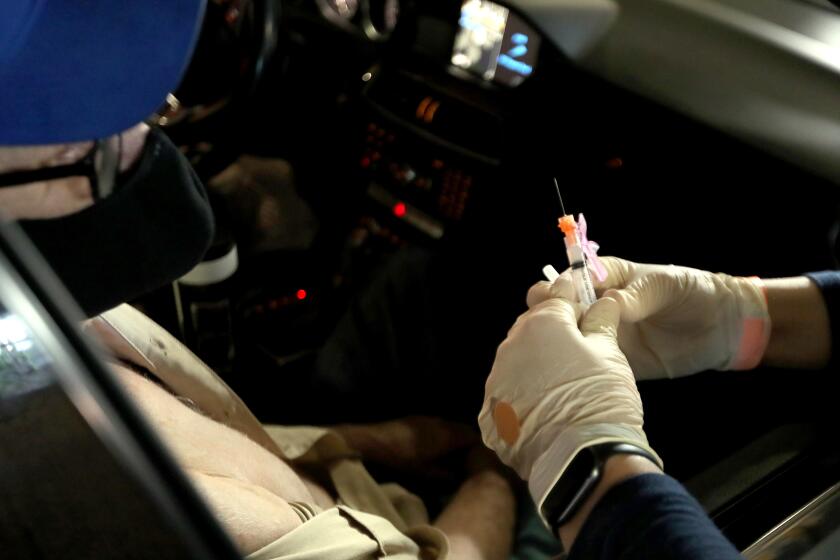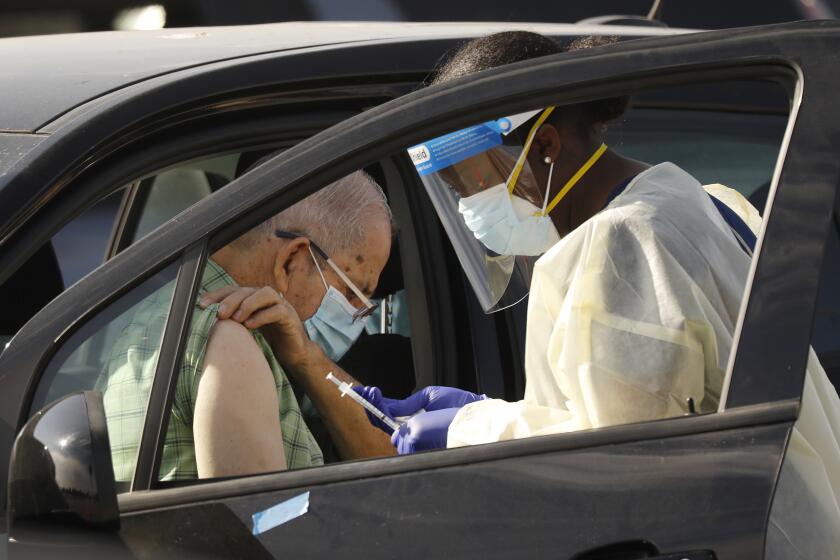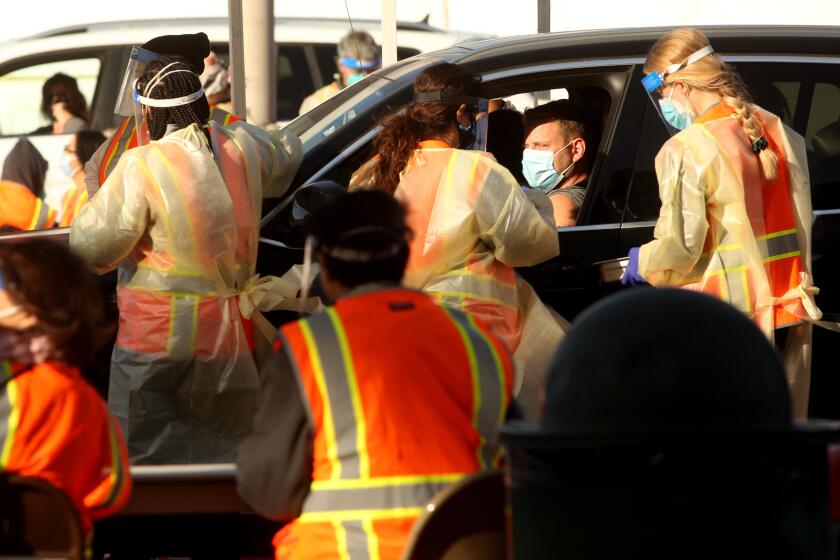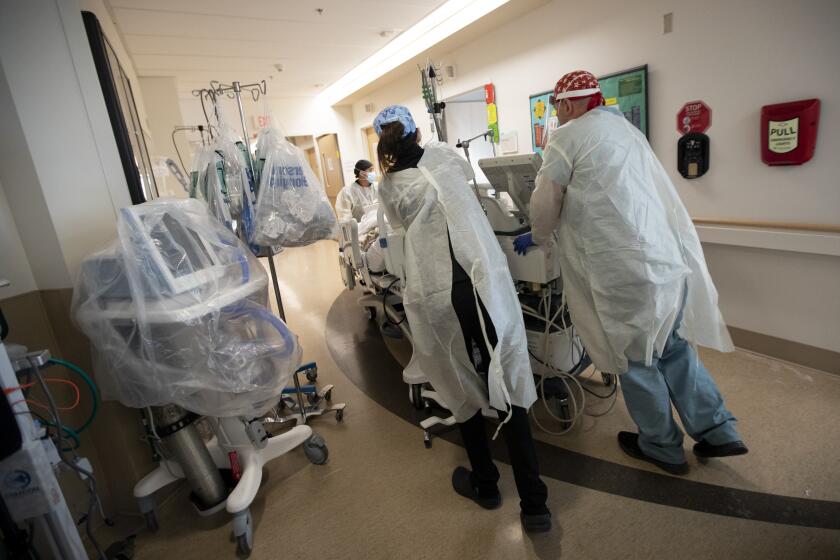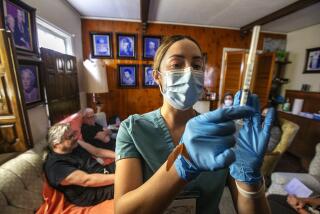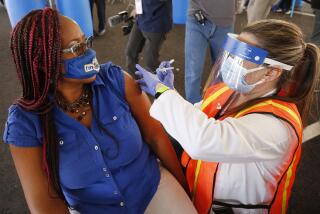L.A. County won’t be fully vaccinated until 2022 unless pace improves, officials warn

- Share via
There is growing concern that Los Angeles County residents won’t be fully inoculated against COVID-19 until next year unless supplies of approved vaccines get a major boost.
L.A. and the rest of the nation are struggling to get enough vaccine to meet swelling demand, especially after California allowed people 65 and older to gain access to the inoculations. But while many are clamoring for the vaccine, officials say they are getting only a fraction of what they need.
Dr. Paul Simon, chief science officer for the Los Angeles County Department of Public Health, said that if weekly vaccine shipments were to increase to 500,000 doses, the county could potentially immunize 75% of its adult population by midsummer.
At the current rate, though, he said the “vaccination effort will likely extend well into 2022.”
Mayor Eric Garcetti said that while the pace of vaccinations will probably accelerate as more doses become available and additional vaccines are approved, the math is challenging in a county of some 10 million people.
Both vaccines approved for public use in the United States — from Pfizer-BioNTech and Moderna — require two doses administered weeks apart. So, Garcetti said, for “the 7.5 million of the 10 million people that the Department of Public Health at the county level expects to get a vaccination,” 15 million doses are required.
The county has been receiving an average of 160,000 doses a week, he said.
Even with the 853,650 doses the county had received by Wednesday, there’s a daunting gap of nearly 14.2 million. At the rate of delivery Garcetti cited, it would take about 88 weeks for enough vaccine to arrive to serve all Angelenos who need it.
Tens of thousands of people face confusion, contradiction and chaos amid the state’s uneven vaccine rollout.
Garcetti said he’s confident that manufacturers will be able to ramp up to meet the demand and that the potential arrival of additional vaccines undergoing review — including one from Oxford University and AstraZeneca and a single-dose offering developed by Johnson & Johnson — will boost the supply further.
“We are ready to do more here,” he said. “It’s going to be a sad day when I stand here saying, ‘Dodger Stadium has the capacity to take in 12,000 people, but we only have vaccines for 2,000.’”
Given the enormous need in the nation’s most populous county, even administering doses to priority groups could be a months-long undertaking unless the supply situation improves.
“If you take the calculation of what the county is getting each week — about 160,000 — and you just look at the number of healthcare workers and seniors, we won’t get through them until June,” Garcetti said.
The state is receiving about 300,000 to 500,000 COVID-19 doses each week, a pace that would take months for priority list residents to get vaccinated.
Health officials across California have expressed frustration at the pace of vaccine deliveries, saying they have plenty of capacity and personnel available but there are nowhere near enough shots to go around.
“We just are not receiving enough vaccine doses to move as quickly as we, and you, would like us to,” L.A. County Public Health Director Barbara Ferrer said this week.
Another problem is that the amount delivered to health agencies has varied week by week; officials say this makes long-term vaccination planning and scheduling of appointments difficult, if not impossible.
“We’re challenged by the unpredictability of the supply each week,” Simon said. “And so we really have to wait and see how much we’re going to be allocated before our providers can start making appointments with their patients.”
Officials in San Francisco warned this week that its public health department was at risk of running out of COVID-19 vaccines, after the city’s allocation dropped substantially from a week ago and doses that had to be set aside were not replaced.
While that situation was averted — thanks to California clearing the use of specific Moderna doses that had been held for additional safety reviews — health officials said that “the city’s providers do not have sufficient vaccine supply to meet the current population that has been designated by the state to be vaccinated.”
Much of December’s distress was driven by hotels and restaurants closing, as tourism and business travel failed to bounce back and dining out was restricted.
Another bottleneck has formed as a number of available shots must go toward second doses within the prescribed three- or four-week time frame. When shortages occur, fewer shots are available for first doses of the vaccine.
That’s certainly the case in L.A. County, where Simon said Friday that he thinks “a majority of the supply next week will go for second doses.”
“There will be some first doses offered, but we want to be very careful, because we can’t predict, unfortunately, the supply chain even several weeks forward,” he said.
Simon acknowledged that there is tension “between wanting to get as many people vaccinated with that first dose [and] with trying to make sure that everybody who’s vaccinated gets the full sequence of two doses.”
He added: “The vaccine trials were done with that two-dose regimen in mind. We know that works. We don’t know exactly what level of protection one gets if there is a delay in that second dose.”
County officials say they have most of the resources — large vaccine centers and personnel to run them — but lack the doses they need.
Another factor is that the criteria for who can be vaccinated — and when — have been somewhat fluid.
While the state originally focused its efforts on healthcare workers and staff and residents of long-term living facilities such as nursing homes, Gov. Gavin Newsom announced last week that people 65 and older could get COVID-19 vaccinations — ballooning the number of eligible Californians but sparking confusion as some counties held off on vaccinating the newly eligible group in the face of limited supplies.
Data on how many vaccines have been administered have been hard to come by, and the numbers are often delayed. According to the California Department of Public Health, providers had reported administering nearly 1.6 million doses statewide as of Tuesday.
There is cautious optimism that California is finally beating back the coronavirus surge that has ravaged the state for months. Daily infection numbers and COVID-19 hospitalizations have declined notably, though they remain far higher than before the pandemic’s third wave struck in early November.
The ultimate indicator of coronavirus spread — the number of deaths — remains high. California broke its record for most COVID-19 deaths in a single day Thursday, with 735.
Though some pandemic indicators appear to be headed in the right direction, officials warn that the progress is precarious.
“Despite these promising trends, I do want to emphasize that the numbers of cases, hospitalizations and deaths remain far too high,” Simon said. “So while there’s reason to be hopeful, we all must be vigilant.”
COVID-19 deaths still stalking California at alarming levels even as cases continue to flatten
Prevention protocols, such as wearing masks in public, regular hand-washing and avoiding gatherings with those outside one’s household remain vital as the vaccination effort ramps up, officials and experts say.
But every new dose, Garcetti said, is “a little bit more sunshine each day, until finally, the clouds have broken.”
“Every vaccine that we distribute here and in sites across our city and throughout our county is the beginning of the end of this terrible year that we’ve been living through,” he said. “It is the hope about days ahead. It is a cure toward a resurrected economy, toward a restored Los Angeles, kids back at school, loved ones close by — each dose an injection of hope in the future.”
Times staff writers Maura Dolan, Colleen Shalby, Hayley Smith and Maya Lau contributed to this report.
More to Read
Sign up for Essential California
The most important California stories and recommendations in your inbox every morning.
You may occasionally receive promotional content from the Los Angeles Times.
